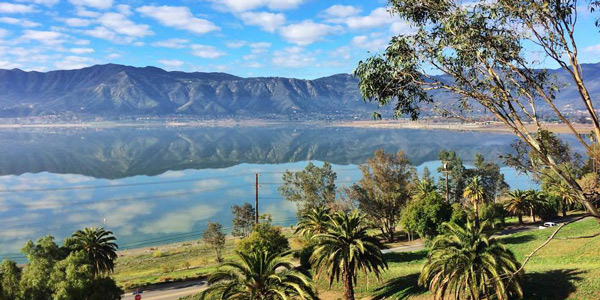By Rich Heidorn Jr.
FERC rejected for a third time a bid by developers to obtain transmission status and cost-based rates for a proposed $2 billion pumped storage project in CAISO (EL19-81.)
The commission dismissed Nevada Hydro’s complaint that CAISO failed to follow its Tariff in studying the Lake Elsinore Advanced Pumped Storage Project (LEAPS) in its transmission planning process.
LEAPS, which has been in development since the late 1990s, would be located about midway between Los Angeles and San Diego in Riverside County, with Lake Elsinore serving as the lower reservoir. Developers say it would produce 6,000 MWh daily, based on 12 hours of operation at the full plant capacity of 500 MW, serving the transmission systems of San Diego Gas & Electric and Southern California Edison.
In a 2008 order, FERC rejected LEAPS’ request to be treated as a transmission asset, saying it would not be appropriate to require that CAISO assume operational control of the project as requested (ER06-278).
Last year, the commission rejected the company’s request for a declaratory order finding that LEAPS is a transmission facility eligible for recovery of its costs through CAISO’s transmission access charge (TAC). The commission sided with CAISO and the California Public Utilities Commission, which had argued that Nevada Hydro’s petition was an end run around the ISO’s transmission planning process (EL18-131). (See FERC Tells LEAPS to Get in Line.)
As a result, Nevada Hydro submitted the project for CAISO’s 2018/19 transmission planning cycle. CAISO’s study of LEAPS was included in its final transmission plan on March 29, 2019, which concluded there was no need for any new transmission projects in Southern California, including LEAPS.
Eight Overloads
Nevada Hydro submitted LEAPS as a transmission solution to eight thermal overloads that CAISO identified on the SDG&E system over CAISO’s 10-year planning horizon. But CAISO did not study it for those violations because the ISO had already decided on other solutions, including remedial action schemes and battery storage and demand response selected by the CPUC in its integrated resource planning (IRP) process.
Nevada Hydro complained that CAISO did not attribute any cost to the batteries, demand response or remedial action schemes, or compare them to the cost of LEAPS to determine which would be more cost-effective. CAISO said because those solutions were already in operation or under construction, they presented no new additional capital costs to consider.
Nevada Hydro also argued that CAISO failed to follow its Tariff requirements for evaluating LEAPS as an economic study request, underestimating its benefits.
The PUC; Six Cities (Anaheim, Azusa, Banning, Colton, Pasadena, and Riverside); the California Municipal Utilities Association; NextEra Energy; and the California Department of Water Resources’ State Water Project opposed Nevada Hydro’s complaint and backed CAISO’s analysis. Opponents contended that LEAPS is primarily a generation facility whose costs should be recovered through market revenues rather than the TAC.
The company did not respond to a request for comment.
No Tx Need
In its ruling, the commission said CAISO’s analysis had followed its Tariff.
“Because CAISO’s studies found no need for new transmission solutions, and because the existing solutions present no new capital costs, we find that CAISO’s Tariff does not require it to compare the cost-effectiveness of LEAPS with that of reliability solutions that are already in operation or under construction, or discuss the pros and cons of relying on existing measures that adequately ensure reliability versus investing in new transmission assets,” FERC said.
“… We continue to find that CAISO’s transmission planning process is designed in a manner that considers the full benefits of any proposed transmission solution, and that CAISO applied its process correctly with respect to its study of LEAPS,” the commission added.
The commissioners also rejected Nevada Hydro’s complaint over CAISO’s use of 4,183 MW of generation and a 2,000 MW export limit identified in the CPUC “default scenario” portfolio, saying the company should have objected during the transmission planning process. “Once the planning assumptions and study plan are adopted, those assumptions are locked in for the rest of the transmission planning cycle,” FERC said.
“We find no merit in Nevada Hydro’s assertion that CAISO abdicated its responsibilities as a regional transmission organization by adopting the CPUC default scenario portfolio. As noted by CAISO, its role is transmission planning, not resource procurement, and nothing in its Tariff requires CAISO to second guess or reverse CPUC’s resource procurement decisions or dictate what resources CPUC-jurisdictional entities can or cannot procure.”
FERC Rejects Rehearing on CAISO Capacity Market
Also last week, FERC denied rehearing on its 2018 order rejecting a request to direct CAISO to develop a capacity market (EL18-177-001).
The request had been made by CXA La Paloma, the operator of a 1,124-MW gas-fired plant in Kern County, Calif. CXA La Paloma contended California’s lack of a centralized capacity procurement was unjust and unreasonable because of falling energy prices that undermined the finances of independent generators. (See FERC Rejects Request for CAISO Capacity Market.)
On rehearing, the commission dismissed contentions that it ignored evidence and misread the law in rejecting La Paloma’s complaint. It also rebuffed requests to conduct a technical conference to examine the state’s existing resource adequacy framework. “The record evidence did not persuade the commission that additional processes, other than those [stakeholder proceedings] noted in the complaint order that were already underway, were necessary.”




